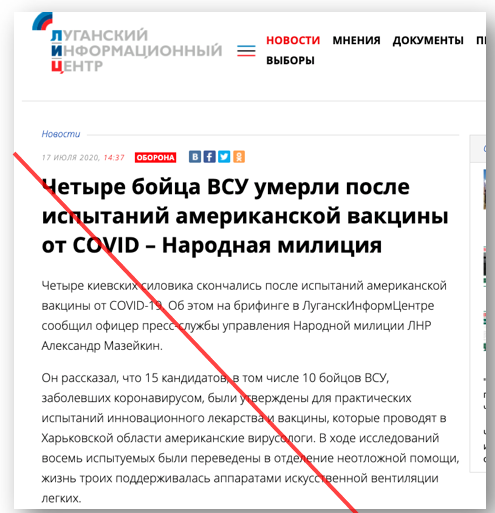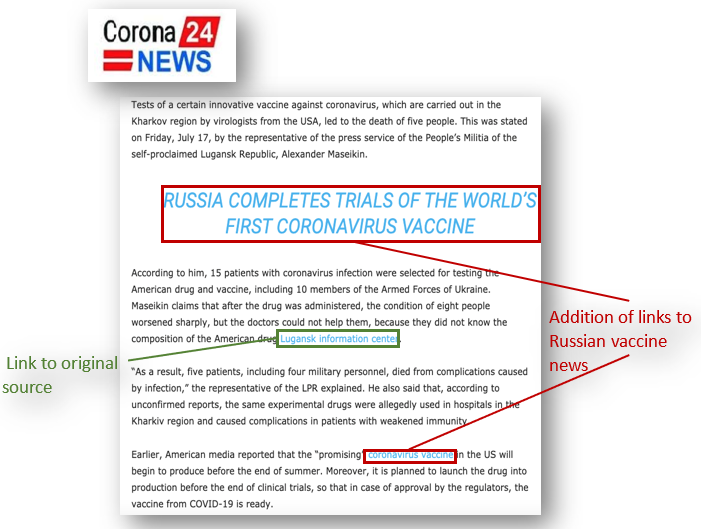
In July 2020, fact-checking and news organizations across Europe and the United States picked up on an emerging disinformation campaign that alleged Ukrainian soldiers died after testing an experimental U.S. COVID-19 vaccine. The story, which was debunked by EUvsDisinfo and other fact-checking organizations, originated at the Lugansk Media Center, an obscure news agency in Luhansk, part of Ukraine’s Donbas region where pro-Russian militias have been operating with the support of the Kremlin since Russia’s invasion of Ukraine in 2014.
The Lugansk Media Center story was amplified over social media and laundered online with the participation of known pro-Kremlin sites pushing Russian strategic narratives and, at times, fake news. For example, the disinformation narrative was further amplified by News Front, a Crimea-based outlet identified by the U.S. State Department as a conduit for Russian disinformation in its August 2020 report, “Russia’s Pillars of Disinformation and Propaganda.” The Lugansk Media Center article also appeared, with slight modifications, on the aptly named—and no longer in existence—corona24[.]news website. Beyond modifications to the original Lugansk Media Center text, the Corona 24 News story also included links to another obscure news story about developments in Russian vaccine research.
From Luhansk to an obscure website network – Introducing the 24 Group
Corona24[.]news, one of the obscure websites pushing disinformation about Ukrainians and the U.S. COVID-19 vaccine, went inactive sometime around late 2020. While live, its operations were suspicious. The website took articles from other sources around the world, including legitimate news outlets, translated the content into English, and republished the text under the banner of “Corona 24 News.” Corona24[.]news published an extremely high volume of articles usually sourced from mainstream news outlets, many from around Europe, and passed them through what appeared to be an automated content delivery system.
Yet some of its stories showed slight modifications, including the article from the Lugansk Media Center, which accused the United States of killing Ukrainian service members with a coronavirus vaccine. In total, Corona 24 News published hundreds of thousands of articles, most direct copies of original source material, making these selective modifications to the Lugansk Media Center piece highly unusual.
The “24 Group”
Corona 24 News operated as part of a collection of websites all constructed in a similar fashion. The “24 Group” network of websites all shared some characteristics: each published—or publishes—a high volume of largely benign content translated into English, sourced from around the Internet, and the sites usually include some reference to “24” in their domain names. Each site is vaguely titled to reflect a country or topical target audience, but the sites’ content is always translated into either English or French. Importantly, none of the news outlets actually exist beyond these obscure, entirely automated websites.
In another example of republishing, a New York Times story covering Russian intelligence-backed COVID-19 disinformation efforts was republished on another similar “24 group” site, fr24news[.]com. Fr24news’ version of the story featured slight text variations and much of the original article’s text was cut out. The republished version—whether advertently or inadvertently—minimized the strength of The New York Times story’s attribution that Russia was the central entity in a broad-based COVID-19 disinformation campaign stretching across many fringe news outlets.
Sampling of “24 Group” websites
italy24news[.]com
de24[.]news
fr24news[.]com
en24[.]news
news24[.]news
saudi24news[.]com
web24[.]news
football24[.]news
What’s the point of these high-volume 24-hour news-looking sites?
The reprint of the Lugansk Media Center article published on corona24[.]news was self-reported as viewed roughly 1,100 times. This traffic may have been directed in part by the dissemination of the article on Twitter or through its placement on Internet forums, perhaps most notably a forum on the anti-establishment, pro-Kremlin website The Saker.
Why does a website like corona24[.]news exist? And why do several other strikingly similar “news” websites exist? In short: We don’t really know. One motivation may be financial. None of this activity is free. Purchasing Internet infrastructure costs time and materials. However, these sites have removed one of the costliest aspects of publishing content: content creation.
While the sites churn out benign content, they also retain their status in search engines and may perhaps be successful in working themselves into news aggregators or picked up by users on social media who aren’t checking their sources. It is through this system that disinformation—such as the story published by the Lugansk Media Center—can be translated, indexed, and fed into the Internet from a source nominally removed from the original publisher. By republishing and integrating benign content from around the Internet, the architects of “24 Group” have eliminated the need to hire staff to write articles and created an information laundering system—one in which a malign actor could strategically drop Kremlin-aligned disinformation for further amplification.
24 Group’s content continues to be recycled through the Internet to limited effect, and the ownership of any of these websites remains unknown. But the network’s interests are obvious: Message in English at a high volume—even if sometimes those messages are fake stories from dubious sources that benefit one entity above all others: the Kremlin.
The views expressed in GMF publications and commentary are the views of the author alone.






